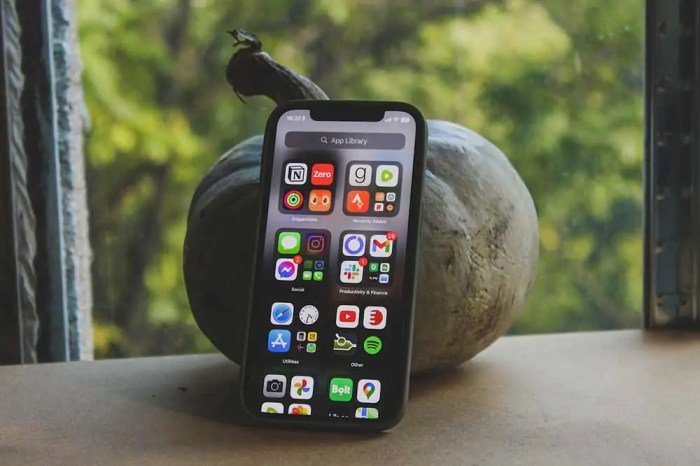Cutting-edge smartphone tech is rapidly reshaping how we connect, communicate, and experience the world. From sleek designs to unparalleled processing power, smartphones have evolved from simple communication devices to powerful, pocket-sized computers. This exploration delves into the core advancements driving this evolution, uncovering the technologies that are constantly redefining the boundaries of what’s possible.
We’ll journey through the visual brilliance of display technologies, the raw power of advanced processors, and the artistry of cutting-edge camera systems. Furthermore, we’ll explore the seamless connectivity that keeps us linked, the intuitive software that shapes our digital experiences, and the innovative materials that define modern smartphone aesthetics. Prepare to discover the future of mobile technology, one innovation at a time.
Introduction to the Realm of Cutting-Edge Smartphone Tech
The smartphone has become an indispensable tool, a portal to information, communication, and entertainment. Its evolution has been nothing short of revolutionary, driven by relentless technological advancements. From the clunky, feature-limited devices of the past to the sleek, powerful computers we carry today, smartphones have transformed the way we live, work, and interact with the world. This article delves into the core technologies that define the modern smartphone, exploring their capabilities and the future they promise.
Display Technologies: The Visual Frontier
Display technology is at the forefront of smartphone innovation, delivering increasingly immersive and visually stunning experiences. The evolution from basic LCD screens to the vibrant displays of today is a testament to the rapid pace of progress.
- OLED (Organic Light-Emitting Diode): OLED displays offer superior contrast ratios, deeper blacks, and wider viewing angles compared to traditional LCDs. They also consume less power, contributing to improved battery life.
- AMOLED (Active-Matrix Organic Light-Emitting Diode): AMOLED is a type of OLED technology that incorporates an active matrix to control each pixel individually, leading to faster response times and enhanced image quality.
- MicroLED: This cutting-edge technology uses microscopic LEDs to create incredibly bright and efficient displays. MicroLEDs offer superior brightness, color accuracy, and energy efficiency compared to OLEDs, although they are currently more expensive to produce.
The refresh rate, measured in Hertz (Hz), plays a crucial role in the smoothness of the user experience. Higher refresh rates, such as 120Hz or 144Hz, result in smoother scrolling and animations, making the interface feel more responsive. Resolution, the number of pixels on the screen, also impacts visual clarity. Higher resolutions, like QHD+ or 4K, deliver sharper images and more detailed content.
Screen size is another key factor, with larger displays providing more immersive viewing experiences for media consumption and gaming. Future innovations include flexible and foldable screens, which promise to revolutionize smartphone form factors and functionality.
| Technology | Advantages | Disadvantages | Current Examples |
|---|---|---|---|
| OLED | Superior contrast, deep blacks, wide viewing angles, energy efficiency | Can be susceptible to burn-in over time | Samsung Galaxy series, Google Pixel series |
| AMOLED | Faster response times, enhanced image quality | Similar to OLED | Samsung Galaxy series, OnePlus devices |
| MicroLED | Superior brightness, color accuracy, energy efficiency | High production costs | Currently limited to high-end TVs and some smartwatches |
Processing Power: The Brains of the Operation, Cutting-edge smartphone tech
The processor, or System-on-Chip (SoC), is the heart of a smartphone, dictating its performance and capabilities. Modern processors integrate a CPU, GPU, and other components onto a single chip, enabling incredible processing power in a compact form factor.
- Snapdragon: Qualcomm’s Snapdragon processors are widely used in Android smartphones, offering a range of performance levels to suit different price points. They are known for their strong performance in gaming and multimedia tasks.
- Apple Silicon: Apple’s custom-designed processors, such as the A-series chips found in iPhones and iPads, are renowned for their exceptional performance and power efficiency.
The architecture of a processor, including its core count (e.g., octa-core) and clock speeds, significantly impacts its performance. More cores and higher clock speeds generally translate to faster processing and improved multitasking capabilities. AI and machine learning are also playing an increasingly important role, with processors incorporating dedicated AI cores to accelerate tasks like image processing, voice recognition, and personalized recommendations.
“The advancements in smartphone processors have unlocked a new era of mobile gaming and multitasking. High-end games now run smoothly with stunning graphics, while users can seamlessly switch between multiple apps without experiencing lag.”
Camera Systems: Capturing the Moment

Source: highstuff.com
Smartphone cameras have undergone a remarkable transformation, evolving from basic single-lens systems to sophisticated multi-lens setups capable of capturing stunning photos and videos. This evolution is driven by advancements in image sensors, lens technology, and computational photography.
- Image Sensors: Larger image sensors capture more light, resulting in better low-light performance and dynamic range.
- Lens Apertures: A wider aperture (lower f-number) allows more light to enter the camera, enabling shallower depth of field and better low-light performance.
- Image Stabilization: Optical Image Stabilization (OIS) and Electronic Image Stabilization (EIS) reduce blur caused by camera shake, resulting in sharper photos and videos.
- Computational Photography: Techniques like HDR (High Dynamic Range), night mode, and portrait mode use software algorithms to enhance image quality.
- Zoom Capabilities: Multi-lens systems with telephoto lenses enable optical zoom, allowing users to capture distant subjects without sacrificing image quality.
- AI Enhancement: AI algorithms are used to optimize image settings, enhance details, and improve overall photo and video quality.
Conclusive Thoughts
From groundbreaking displays to lightning-fast processors and sophisticated camera systems, the evolution of cutting-edge smartphone tech continues at an astonishing pace. As we look ahead, the convergence of augmented reality, foldable designs, and enhanced connectivity promises to redefine our interactions with the digital world. Embrace the future, as smartphones continue to push the boundaries of innovation, offering us unprecedented power and possibilities right in the palm of our hands.
